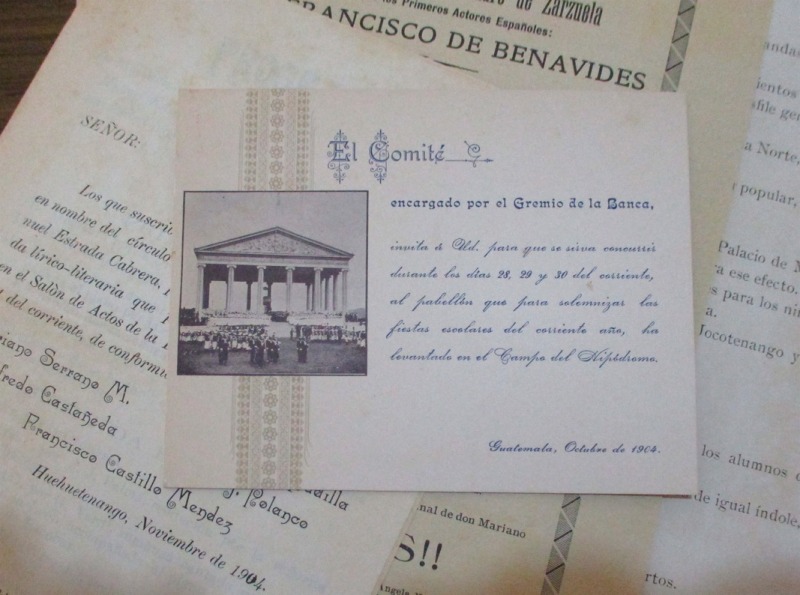Michael Kirkpatrick conducting research in Guatemala City

Memorial historian explores unpublished sources at the National Library and General Archives.
“I returned to Guatemala this past May for the first time in nearly four years to conduct research in the capital city. This was my sixth time conducting research in Guatemala City since I was a Master’s student in 2004. During my last two visits, I have stayed at the lovely Pan-American Hotel on Ninth Street. The Pan-American—the hotel of choice during the 1960s for flight crews from Pan-American Airlines—has a quaint restaurant where I could eat all the tortillas, tamales, black beans, and guacamole I desired. The hotel is conveniently located a block away from the Central Plaza and a three-minute walk to the National Library and General Archive of Central America where I conducted the majority of my research.
I have long enjoyed conducting research at the National Library which houses two of my favourite collections in Guatemala. The first is the newspaper collection of the Hemeroteca Nacional, which contains hundreds of newspapers of varying runs that date back to the nineteenth century. As my research looks at bourgeois and working-class social and cultural history in late-nineteenth and early-twentieth-century Guatemala City, this newspaper collection is indispensable in detailing day-to-day events and experiences in the capital. The second collection of documents available at the National Library is found in the Fondo Antiguo and consists of hojas sueltas: pamphlets, street literature, manifestos, accusations, gossip, and advertisements that were circulated around Guatemala City and collected by the Valenzuela family. Publishing and distributing hojas sueltas was a manner through which popular grievances could be aired, tarnished reputations could be defended, and public and private events could be announced. The fact that the hojas sueltas could be published anonymously meant that libelous statements and outrageous accusations were made with little consequence. These documents provide insights into opinions and activities sometimes overlooked by newspapers and official correspondences. One of the most interesting hojas sueltas I found on my trip was a denunciation written by a madam who managed a number of brothels and who was keen to defend the honour of her sex workers from the ridicule of bourgeois newspaper editors in the 1890s.
At the General Archives of Central America, I limited my research primarily to examining documents from the Ministry of Governance and Justice, court records, and provincial files. The nature of these documents varies widely, consisting of correspondence between government departments as well as reports from police agents and the Legislative Assembly. They also include petitions addressed to the President or to local governors by vested interests, political clubs, and individuals seeking recompense for perceived wrongs like the working-class woman whose neighbour built a privy next to her kitchen window or the residents who protested against local hustlers who monopolized food supplies and charged extortionary rates for produce. Through such documents I can glean insights into the social history of the period, understanding, for example, how changing economic conditions altered the urban face of the city and the lived experiences of its inhabitants.
As much as I love the capital for its people, beautiful architecture, and sunny days, working in Guatemala City can often be difficult and stressful. The city has changed immensely since I first visited Guatemala in 2004 in ways that are often contradictory. Gone are the vendors who lined Sixth Avenue—locally known as La Sexta or simply “Sixth”—for about ten blocks from the Central Plaza to just north of the Civic Center. For decades these vendors sold everything from fruits and textiles to pirated DVDs and electronics, occupying the sidewalks with their wares and tables. But the crowding and bustle of the street also provided a cover for crime. A number of years ago, the Municipality passed new bylaws which pushed these venders off the sidewalks, relocating them away from the historic core, and closed Sixth Avenue to vehicular traffic. The aim was to recreate La Sexta of old. Historically, the avenue was the premiere downtown shopping district, the site of Parisian-style arcades, movie theatres, department stores, jewelers, and cafes. For both elite and working-class Guatemalans, La Sexta was one of the principal locales for strolling, window-shopping, and peacocking. So common were these social practices that they gave rise to the verb sextear: to promenade or saunter along Sixth Avenue. By and large, the Municipality’s efforts were successful in drawing middle-class Guatemalans back downtown and reducing crime along La Sexta. Whereas a decade ago, the historic core was often abandoned around dusk each evening, today one can see families, couples, and young folks walking along La Sexta after dark. From the perspective of a foreign researcher staying near the Central Plaza, these changes are most welcome. Nevertheless, like many problems in Guatemala, the ‘cleansing’ of La Sexta was not accomplished by addressing social ills like crime, poverty, and violence but rather by spatially displacing these difficulties: the avenue’s vendors, for example, were simply pushed to less safe parts of the city, like the notoriously dangerous 18th Street. These changes remind us that the historical forces that shaped the city a century and a half ago continue to affect everyday life for inhabitants of Central America’s largest metropolitan area.”
Dr. Michael Kirkpatrick, Department of History